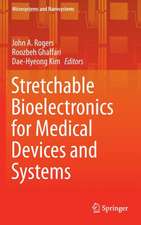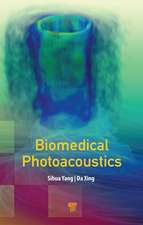A Practical Guide to Optical Microscopy
Autor John Girkinen Limba Engleză Hardback – 25 iun 2019
Optical microscopy is used in a vast range of applications ranging from materials engineering to in vivo observations and clinical diagnosis, and thanks to the latest advances in technology, there has been a rapid growth in the number of methods available.
This book is aimed at providing users with a practical guide to help them select, and then use, the most suitable method for their application. It explores the principles behind the different forms of optical microscopy, without the use of complex maths, to provide an understanding to help the reader utilise a specific method and then interpret the results. Detailed physics is provided in boxed sections, which can be bypassed by the non-specialist.
It is an invaluable tool for use within research groups and laboratories in the life and physical sciences, acting as a first source for practical information to guide less experienced users (or those new to a particular methodology) on the range of techniques available.
Features:
- The first book to cover all current optical microscopy methods for practical applications
- Written to be understood by a non-optical expert with inserts to provide the physical science background
- Brings together conventional widefield and confocal microscopy, with advanced non-linear and super resolution methods, in one book
Preț: 1098.21 lei
Preț vechi: 1479.57 lei
-26% Nou
Puncte Express: 1647
Preț estimativ în valută:
210.14€ • 219.99$ • 173.88£
210.14€ • 219.99$ • 173.88£
Carte tipărită la comandă
Livrare economică 07-21 aprilie
Preluare comenzi: 021 569.72.76
Specificații
ISBN-13: 9781138065062
ISBN-10: 1138065064
Pagini: 278
Ilustrații: 282
Dimensiuni: 178 x 254 mm
Greutate: 0.45 kg
Ediția:1
Editura: CRC Press
Colecția CRC Press
ISBN-10: 1138065064
Pagini: 278
Ilustrații: 282
Dimensiuni: 178 x 254 mm
Greutate: 0.45 kg
Ediția:1
Editura: CRC Press
Colecția CRC Press
Cuprins
1. Introduction. 2. Understanding Light in Optical Microscopy. 3. Basic Widefield Microscopy. 4. Advanced Widefield Microscopy. 5. Confocal Microscopy. 6. Fluorescence Lifetime Microscopy. 7. Single Plane Illumination Microscopy. 8. Multiphoton Fluorescence Microscopy. 9. Harmonic Microscopy. 10. Raman Microscopy. 11. Holographic Microscopy. 12. Super Resolution Microscopy. 13. How to Obtain the Most from your Data. 14. Selection Criteria for Optical Microscopy.
Notă biografică
John Girkin is professor of Biophysics at Durham University and Director of the Biophysical Sciences Institute in Durham. He moved to Durham in 2009 to take up this role having previously founded the Centre for Biophotonics at Strathclyde University, Glasgow where he was one of the first leaders at the Institute of Photonics. Originally trained as a physicist at Oxford and with a PhD from Southampton University (in Laser Spectroscopy of Atomic Hydrogen) he worked for ten years in industry including developing the world’s first diode laser retinal photocoagulator and diode pumped Nd:Yag laser. He moved back into academia in 1996 as one of the original Research Team Leaders at the Institute of Photonics, Strathclyde University.
His research focuses on the development of novel optical instrumentation to help solve challenges within the life sciences. His research covers a very broad range of activities from dental imaging in the near infrared through to rapid-genomic screening but an ongoing theme has been in developing and applying optical microscopy methods to life science challenges. His initial focus was in non-linear microscopy and he was one of the first pioneers in the use of adaptive optics in microscopy and has more recently been developing advanced forms of single plane illumination microscope for in vivo zebra fish imaging. A constant within his research has been to select the most suitable method for a specific task.
He has published over 100 peer-reviewed publications, is a Fellow of both the Institute of Physics and the Optical Society of America serving on both national and international review panels in the area of biophotonics and microscopy.
His research focuses on the development of novel optical instrumentation to help solve challenges within the life sciences. His research covers a very broad range of activities from dental imaging in the near infrared through to rapid-genomic screening but an ongoing theme has been in developing and applying optical microscopy methods to life science challenges. His initial focus was in non-linear microscopy and he was one of the first pioneers in the use of adaptive optics in microscopy and has more recently been developing advanced forms of single plane illumination microscope for in vivo zebra fish imaging. A constant within his research has been to select the most suitable method for a specific task.
He has published over 100 peer-reviewed publications, is a Fellow of both the Institute of Physics and the Optical Society of America serving on both national and international review panels in the area of biophotonics and microscopy.
Recenzii
"Although one might assume that many books on microscopy already existed, this reviewer was pleasantly surprised to discover here just how far and how quickly the field has recently moved. Girkin (Durham Univ.) provides a historical overview in the early chapters; though brief, it will be a helpful refresher or introduction for readers new to the subject. The majority of chapters cover advanced topics, including, for example, light sheet microscopy, multiphoton fluorescence microscopy, and digital holographic microscopy. Many of these techniques are new since the development of modern laser systems. It is unlikely that any single lab will use all the covered methods simultaneously, but this book provides a handy comprehensive reference for a general understanding of how the optical method works in the context of various applications and how the data are collected and analyzed in different scenarios…The book will be broadly useful as an authoritative source, especially as most methods introduced are accompanied by a separate explanation of the underlying physics, evidently to avoid overwhelming readers looking for a more general understanding.
Summing Up: Recommended. Upper-division undergraduates through faculty. Students enrolled in two-year technical programs."
—T. P. Owen Jr., Connecticut College in CHOICE, March 2020
Summing Up: Recommended. Upper-division undergraduates through faculty. Students enrolled in two-year technical programs."
—T. P. Owen Jr., Connecticut College in CHOICE, March 2020
Descriere
This book is aimed at providing users with a practical guide to help them select, and then use, the most suitable method for their application. It is an invaluable tool for use within research groups and laboratories in the life and physical sciences.













